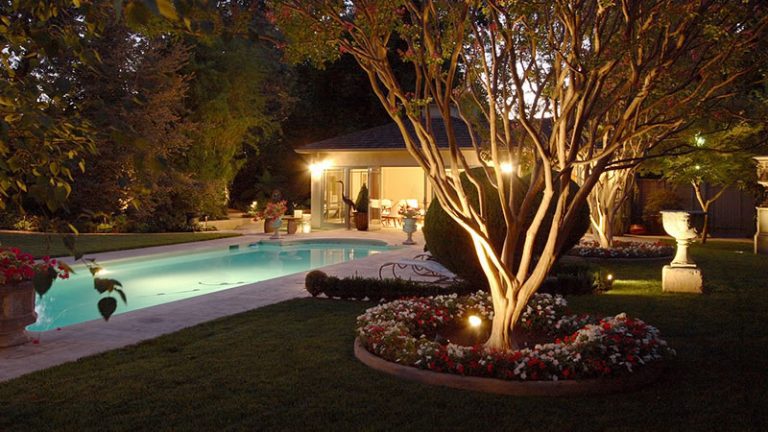Landscaping Ideas Around Septic Tank Areas: 7 General Guidelines to Follow
As Malibu’s premier landscape specialists, we field questions all the time about landscaping ideas around septic tank areas. Properties in Malibu, CA, depend on septic systems for their wastewater. By following some general guidelines, you can choose the best plants for your septic drain areas and consider the best options for your landscape plan. Regular maintenance, along with the right types of plants, will help ensure the optimal performance of your septic system.
1. Understand How a Septic System Functions
When it comes to landscaping ideas around septic tank areas, you first need to understand the basics of what the system does. A septic tank separates solids from liquids. The wastewater flows from the tank into a series of drain lines that allow the water to slowly percolate down through the soil in the drain field. This is also known as a leach field.
Soil microbes filter the wastewater before the harmful bacteria reaches groundwater. To function properly, these microbes require oxygen. For this reason, compacted or saturated soils will hinder the ability of soil microbes to do their job.
To avoid soil compaction, we recommend minimizing foot traffic and avoiding excess water runoff on the drain field. To be on the safe side, we suggest diverting water runoff from driveways or sidewalks away from the drain field. It’s also important to make sure irrigation systems do not add excess moisture. A good rule of thumb is to position sprinklers to keep water ten feet away from the drain field.
Generally speaking, most septic drain fields consist of a series of perforated pipes that are placed in trenches and buried with aggregates of gravel or chips and soil. The drain lines are at least six inches deep and eighteen to thirty-six inches wide. There are usually about eight to ten feet between each drain line. Because every septic drain field is different, make sure you have a detailed layout of your particular system so you know the locations and dimensions of each component. This knowledge will be important when you’re considering landscaping ideas around septic tank systems.
The drain field is a critical part of your septic system. Avoiding some common mistakes with landscaping ideas around septic tank areas is vital. The most important thing to know is that tree roots and other deep roots can grow into the drain lines. Also, heavy machinery, large animals, and other heavy items can break drain lines. This can cause the drain field to fail. If the drain field fails, your septic system fails.
Take Precautions to Prevent Problems With Your Septic System
It’s important to take proper care of your septic system by using bacteria and enzyme treatments to help prevent backups. If you notice noxious odors, water pooling in the yard, or gurgling in the pipes, you most likely have a clog that needs immediate attention or an emergency formula treatment.
2. Protect Your Septic Drain Field
Locate your septic tank and drain field. Make sure the area is clear of:
- Underground sprinkler lines
- Decks and patios
- Sports courts
- Storage sheds
- Swing sets
- Sandboxes
- Driveways
- Vehicles
3. Properly Landscape on Septic System Drain Fields
Soil erosion can leave the drain field more vulnerable to damage. One of the best reasons for planting on a septic field is that it helps stabilize the area and mitigates any soil erosion. In addition, plants optimize oxygen exchange and remove excess soil moisture.
Making good choices of plants and avoiding others on or around the drain field area will protect the environment and avoid costly repairs. A professional landscape designer can come up with landscaping ideas around septic tanks areas and select the right plants for your individual septic system.
The right plantings can also help disguise septic tank components. In addition, you can choose faux elements such as decorative tank riser covers, or lightweight natural looking rock covers.
4. Choose Correct Plantings for Septic Areas
The key to landscaping ideas around septic tank areas is to select plants that do a great job in meeting landscaping needs while minimizing threats to the drain field. Lawn grass is one of the best ground covers for a drain field. Avoid certain types of vegetation with aggressive root systems that pose a threat to the drain pipes. Plants that don’t require too much maintenance are a good idea.
Herbaceous Plants
Herbaceous plants with shallow roots and those that don’t require much water are your best bet for septic drain fields. This includes herbaceous perennials, flowering annuals, flowering perennials, bulbs, turfgrass, weeds, and many groundcovers. A mix of wildflowers, bulbs, and grasses is a good way to achieve an attractive vegetative cover. Keep in mind that larger plants usually have larger root systems. For this reason, we do not recommend tall grasses such as pampas grass.
Thirsty plants that require a lot of water and have aggressive roots can cause damage to the drain field and threaten the environment. Deeper roots can clog or dislodge the pipes which can lead to expensive repairs. Avoid these types of plants in your landscaping ideas around septic tank areas.
Recommended Types of Plants in California
Native Drought Tolerant Plants
As a general rule, California native plants and native grasses are some of the best choices for your septic system.
Types of Grasses
- Fescue
- Lawn
- Ornamental grasses
- Wildflower meadow mixes
Groundcovers for Sun
- Bugleweed (Ajuga)
- Carpet heathers (Calluna Vulgaris)
- Ground ivy (Glechoma)
- Kinnickinick (Arctostaphylos)
Groundcovers for shade
- Bunchberry (Cornus)
- Ferns
- Mosses
- Sweet woodruff (Galium Odoratum)
- Wild ginger (Asarum)
- Wintergreen (Gaultheria)
Note: In Malibu, these species are non-native and are only permitted within fifty feet of a primary residence.
5. Avoid The Wrong Plants Around A Septic System
Large shrubs and plants with woody stems are more likely to damage drain fields with their root systems. Do not plant large trees with aggressive root systems near a septic system. This includes willow trees, maple trees, beech trees, birches, poplars, and elms.
Keep in mind that the septic drain field needs sun to perform optimally, so it’s important not to heavily shade the area with trees and shrubs. Should you decide to plant less aggressive, shallow-rooted shrubs or small trees in the drain field, make sure to plant them between the drain lines.
Remember, not all systems are alike. Always refer to your layout diagram for the exact locations and dimensions of your septic system’s design. Planting trees and shrubs near a drain field always runs the risk of potentially damaging the drain lines, so it’s important to use caution. If trees or large shrubs are already planted near your septic system, it’s not a cause for concern as long as they are at least fifty feet away.
6. Don’t Try To Grow Vegetables Over a Septic Drain Field
Although the open area of the drain field may seem like a good place to grow a vegetable garden, it is not recommended. The obvious reason is the health risks associated with bacterial contamination from wastewater. Not only that, but vegetable gardening requires frequent cultivation of the soil, additional water, and fertilization. None of which are recommended for a drain field.
7. Follow The Do’s and Dont’s for Landscaping Ideas Around Septic Tank Areas
Do:
- Grass or existing native vegetation is the best ground cover for your drain field.
- Direct all surface drainage away from the septic system.
- Use plants with shallow root systems (see plant list above).
- Tree and shrub roots can grow into the drain lines, clogging and breaking them.
- Avoid water-loving plants and trees.
- Make sure your septic tank lid is secure.
Don’t:
- Plant a vegetable garden on or near the drain field.
- Put plastic sheets, bark, gravel, or other fill over the drain field.
- Reshape or fill the ground surface over the drain field and reserve area. However, just adding topsoil is generally safe if it isn’t more than a couple of inches.
- Create ponds on or near the septic system and the reserve area.
To conclude, landscaping ideas around septic tank areas have an impact on its longevity. The right type of vegetation over the drain field will hold the soil in place and increase the efficiency of the system. However, it’s essential to follow certain guidelines and conduct routine maintenance to avoid costly repairs and unpleasant malfunctions.
Do You Need Help With Landscape Ideas At Your Malibu, CA Property?
Malibu Nursery & Landscaping is a full-service landscaping contractor serving Malibu, CA, and the surrounding areas of Calabasas, Agoura Hills, and Westlake Village. We specialize in estate and high-end landscape solutions for our residential and commercial clients. If you’d like assistance with your landscape needs, our in-house team can offer the professional advice you need to get started right away.
If you’d like to schedule a consultation to discuss your landscape needs, we’d be happy to meet with you. Please call 805-905-1112. Or, fill out our online form, and we’ll get right back to you.










